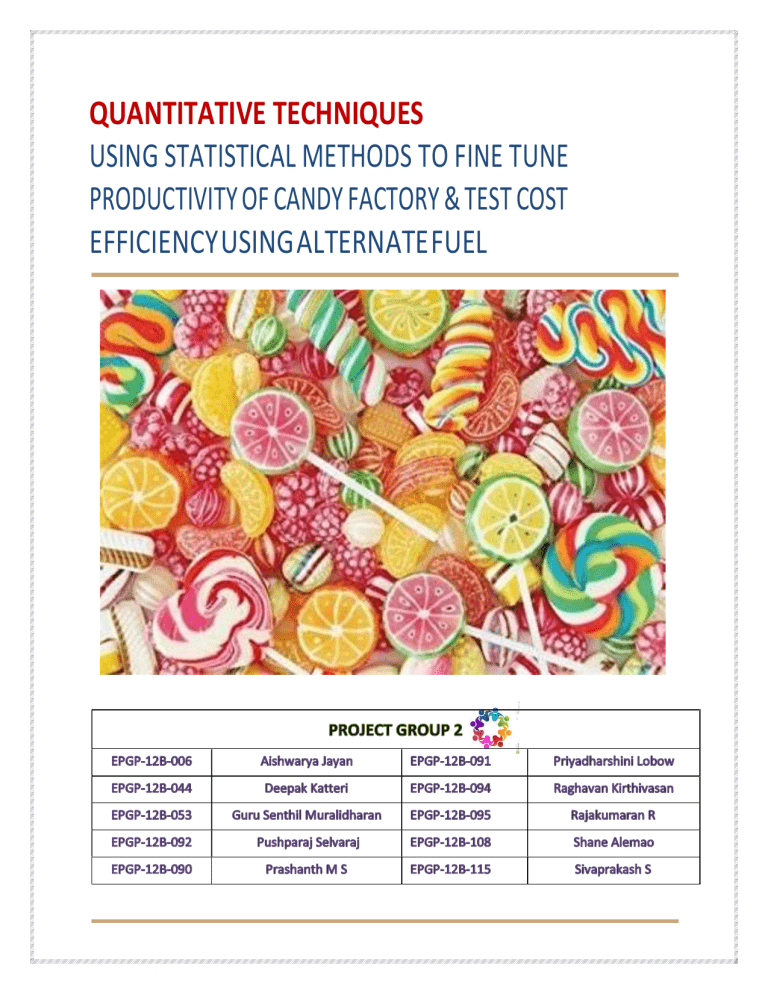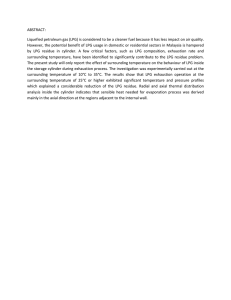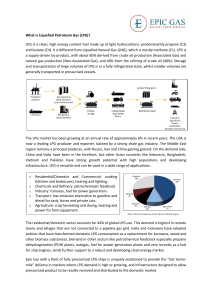
QUANTITATIVE TECHNIQUES
USING STATISTICAL METHODS TO FINE TUNE
PRODUCTIVITY OF CANDY FACTORY & TEST COST
EFFICIENCY USING ALTERNATE FUEL
Table of Contents
Introduction & Motivation
Confidentiality
Data source
Problem statement
Data analysis for fine-tuning productivity of production plants
Source data
Analysis
Graphical representations
Using probability distributions to analyze the efficiency of cost/productivity in different possible
scenarios
Binomial distribution
Poisson distribution
Using hypothesis analysis for an increase cost efficiency with alternate channel
Conclusion
2
Introduction & Motivation
The challenge faced by any production industry is to make use of its available resources in the best possible
way to increase the output and reduce the cost consistently. Especially in companies with multiple plants
of varying output efficiency producing the same product, it is very essential to define the best possible way
to use them in order to get the best efficiency.
Fuel is one major influencer is deciding the cost efficiency of manufacturing. Looking out for cheaper
alternative fuels and getting them implemented in a consistent way will help companies to increase margins
and keep them ahead of the competition.
In this project, we have used statistical methods for analyzing the productivity of plants, for understanding
cost-effectiveness probabilities under different scenarios and a hypothesis analysis to analyze if we can
achieve the cost-effectiveness expected by the company using alternative fuel.
Confidentiality
We thank the organization and its staff who have provided their valuable data for this project. The data
represented here are actuals to the extend permissibly. Some of this data might of competitor interest. We
request for viewer’s discretion in sharing data represented in this report.
Data Source
We have used data from Sweetco Foods Limited. manufacturers of candies and confectionaries have its
debut in Nigeria. With a keen focus on Quality and adoption of international standards, Sweetco Foods
Limited earned an enviable position in the confectionery market in Nigeria. The data presented is their
output data from plants and output results by changing to the alternate.
Problem Statement
Our approach in this project is to give an analysis of the effective usage of current working plants
Testing the output probability of different working cases for cost and production efficiency
Company has decided to take a shift from the conventional use of diesel as the fuel to LPG expecting
a reduction in overall cost by 10% in a short run and 30% reduction in cost in long term
3
Data Analysis for Fine-tuning Productivity of Production Plants
Source Data
Description
Count
Plant 1
Plant 2
Plant 3
Plant 4
Plant 5
11,898.55
280.98
15,493.28
0.00
7,240.36
12,517.29
274.05
15,454.80
0.00
7,061.76
10,398.42
278.61
13,265.85
0.00
7,179.38
15,107.82
223.82
15,844.61
0.00
5,767.56
18,226.42
232.21
19,271.93
0.00
5,983.64
5,24,22,875.50
-0.96
-0.92
19,537.20
0.00
19,537.20
4,98,68,439.51
-0.62
-1.01
23,036.40
0.00
23,036.40
5,15,43,471.54
-1.27
-0.56
32,018.78
0.00
32,018.78
3,32,64,778.10
3.60
-0.19
38,922.62
0.00
38,922.62
3,58,03,926.99
3.44
-1.57
38,272.50
0.00
38,272.50
79,00,638.75
0.61
664.00
83,11,482.90
0.56
664.00
69,04,548.29
0.69
664.00
1,00,31,593.52
0.38
664.00
1,21,02,339.60
0.33
664.00
Correlation Table
1
2
51.37%
2
3
15.79%
21.32%
3
Graphical View
4
4
1.31%
2.20%
-2.32%
4
5
11.93%
10.78%
-0.58%
61.09%
Key Insights
Plant 5 has seen the maximum Production
It's also the most consistent as it has the lowest standard deviation and coefficient of variation
Plant 4 is also the most consistent in terms of output after plant 5
A quick analysis of the performance shows that there is medium correlation between outputs of
plant1 and plant 2 & plant 4 and plant 5
Plant Productivity – Trend Analysis
Key Insights
5
Using Probability Distributions to Analyze the Efficiency of Cost/Productivity in
Different Possible Scenarios
Probability Distribution - Random Variable
Considering the Production in the month of Jan 2020, there were 22 production days out of which
Plant 3 was productive only on 15 days.
Production Data
12,830.40
17,496.00
14,531.40
11,372.40
17,204.40
17,496.00
18,370.80
14,673.15
17,204.40
16,912.80
16,912.80
16,912.80
12,538.80
15,163.20
16,329.60
16,038.00
12,279.60
12,830.40
17,204.40
18,079.20
16,912.80
14,077.80
13,996.80
19,245.60
14,904.00
10,206.00
17,204.40
18,079.20
17,204.40
14,624.55
17,496.00
12,976.20
23,036.40
17,496.00
11,080.80
17,204.40
17,496.00
16,329.60
13,085.55
12,830.40
16,621.20
18,079.20
17,204.40
14,239.80
9,959.76
16,820.93
12,818.58
0.00
0.00
0.00
0.00
0.00
16,599.60
12,412.81
16,378.27
15,492.96
0.00
0.00
9,959.76
16,378.27
11,352.28
9,959.76
22,132.80
17,484.91
17,263.58
13,399.57
Probability of Productive vs Non-Productive
6
11,022.34
16,763.14
13,447.82
9,644.54
18,600.19
18,600.19
18,600.19
13,988.42
18,370.56
18,140.93
17,911.30
17,911.30
11,251.97
18,140.93
2,774.72
0.00
0.00
14,007.55
18,140.93
18,140.93
17,222.40
13,658.32
11,955.60
21,870.00
16,819.65
7,873.20
22,453.20
16,839.90
16,912.80
14,341.05
23,036.40
21,870.00
22,744.80
23,036.40
15,746.40
22,453.20
22,744.80
16,276.95
18,504.45
18,370.80
18,877.05
21,870.00
22,453.20
17,398.80
59,764.90
92,195.66
72,521.45
39,096.14
75,462.19
71,015.29
71,088.19
57,627.17
92,706.96
82,312.74
96,983.57
90,849.46
50,617.97
72,961.73
69,304.88
65,022.82
55,221.88
67,998.91
92,976.38
93,654.24
91,056.38
72,774.29
Plant-3’s management would like to determine the probability of plant not being effectively utilized
in a month over its productive utilization.
Find the Probability of both Plant-3 and Plant-4 being productive on a given day in Jan 2020.
What is the probability that on a randomly chosen day in Jan 2020, all 5 plants were operational
and, on an average, produced more than 60K?
Probability Distribution – Discrete Variable
Fuel Cost Data – 2019
Month
Total
Sum of Total Cost
of LPG
Sum of Total Cost
of Diesel
₹ 10,194.50
₹ 10,364.25
₹ 9,798.77
₹ 8,486.06
₹ 9,793.50
0
0
0
0
0
₹ 8,398.38
₹ 8,549.82
₹ 12,703.99
₹ 12,073.03
₹ 11,648.46
₹ 9,161.00
0
0
0
0
0
0
₹ 11,615.04
0
₹ 1,22,786.81
0
S No
1
2
3
4
5
Range
8000 to 9000
9000 to 10000
10000 to 11000
11000 to 12000
> 12000
Probability
0.25
0.25
0.17
0.17
0.17
What is the probability that total LPG consumption in a month of the year 2019 is at at-most
10000?
This means, in a year at-most 50%, monthly expenditure on LPG is less than equal to 10000.
7
Cost of LPG consumption in 2019 on an average crossed 10K per month for 6 times. What is the
probability that the cost of the LPG consumption will cross 10k for 2 months during the duration of the
first 6 months in 2020? (Poisson)
This means there is a 23% chance that the monthly average consumption of LPG will be more
than 10k in 2 months of Q1/Q2 in 2020.
In the month of Mar 2018, 50% of productive days have run the plant using diesel. On a chosen
sample of 10 days in that month, find the probability of at-least on 3 days plants used LPG (Binomial)
Probabilities
Binomial Value
P(X=0)
0.0009766
P(X=1)
P(X=2)
P(X=3)
0.0097656
0.0439453
0.1171875
0.1718750
So, for the chosen 10 sample days – 83% probability that 3 or more days used LPG over Diesel.
Using Hypothesis Analysis for an Increase Cost Efficiency with Alternate Channel
Hypothesis analysis reflect the following interpretations –
After shifting from diesel to LPG as the fuel for the boiler, we expect a 10% drop in the cost of fuel
per day per unit of unit.
From the diesel population data, the mean cost of fuel per day per unit of output is 11.77 NGN.
After switching to LPG, we expect the mean cost of fuel per day per unit of output to drop by 10%
(in the short run) to 10.593 NGN.
To validate this claim, we perform a hypothesis testing. After 3 months of production with LPG as
the boiler fuel, we consider a sample of 61 data points (removing outliers) for the hypothesis
testing. The status quo scenario is that the mean cost of fuel per day per unit of output is greater
than or equal to 10.593 NGN. We perform the testing at a significance level, α = 0.05.
µ0 = 10.593
8
Null hypothesis, H0: u ≥ 10.593
Alternate hypothesis, Ha: u < 10.593
Number of sample data points, n = 61
LPG population data is not available, and population standard deviation is unknown.
Therefore, we need to assume that the population being sampled is normally distributed. We will
have to use t distribution for the hypothesis testing.
Sample mean, x̄= 10.0527
Sample standard deviation, s = 1.8654
Degrees of freedom, df = 60
t = (x̄ - µ0) / (s/√n) = -2.2623
tα, df = t0.05,60 = -1.6706
α = 0.05
p-value = 0.01367 (calculated)
Since t < tα and p < α, the test is significant, and we reject H0. We can hereby state with 95%
confidence that the firm has achieved a 10% decrease in the cost of fuel per day per unit of output.
We can also determine the 95% confidence interval.
α = 0.05
α/2 = 0.025
upper limit = x̄ + (tα/2*[ s/√n]) = 10.5303
lower limit = x̄ - (tα/2*[ s/√n]) = 9.57499
Therefore, the 95% confidence interval for LPG population mean is [9.57499,10.5303]
Conclusion
Based on the above analysis and the LPG population data (from March 2018 till January 2020), we find –
9
This page is left blank
intentionally
10





